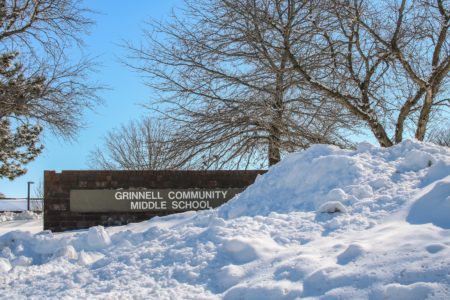The weather in Grinnell has been colder in the past few weeks than in any year since 1996. As the city runs low on salt for the roads and city workers go on overtime, street maintenance is becoming a problem.
Duane Neff, Public Services Director for the City, described the situation. “Financially, we’re still doing okay, but there’s a lot of overtime,” he said. “We’ve been getting a little rest in between, enough to keep [city workers] going.”
There are always about 12 people working, with some workers working shifts for 14 hours straight.
With current snowfall estimated at 15 inches, Grinnell is working hard to keep the roads as safe as possible until the next salt shipment. That means that major intersections have priority, while everywhere else is being rationed.
The winter weather has also adversely affected the Grinnell-Newburg School District, which has been forced to delay or cancel classes numerous times. In the month of January, ten of the twenty school days scheduled were either delayed or canceled.
Over 800 tons of salt have been used so far to keep the roads clear this winter. Recently, a shipment of 50 tons was used in three days. Last year the town only used 650 tons of salt throughout the entire winter.
Salt shortages are exacerbated by shipment delays from the company in Kansas that supplies Grinnell’s road salt.
“The biggest problem we’re having now is just delivery to us,” Neff said. “When they called us, they said they had been sitting at the mine for 20 hours.” There are currently five more loads that are schedules to arrive.
Until then, the city will use brine, which is a salt and water mix, and sand. These options are poor alternatives in the long run. When snow melts or there is rain, Brine gets washed away and becomes useless to melt snow. Sand is also a poor substitute because it makes the streets dirty and can be carried by water into the storm sewers. This clogs the storm sewers and can cause further problems in the future.
The County Engineer assistant Terry Pickett has noted a few problems that have occurred due to the large amounts of snow. A couple of mail boxes were accidentally hit by snow plows as workers cleared the street, though that is the extent of property damage that has been reported to Pickett’s office.
On the other hand, city equipment has suffered damage. There have been instances where the equipment has broken while clearing roads.
“Things happen when you get into big snow events, but we’ve been able to keep up with that,” Pickett said. “Our crews have been doing this for a lot of years, so they’re pretty prepared on how to handle this situation.”
Rural areas often have more trouble than big cities when snowstorms hit.
“We’ve had people call in and wonder when there’s a [snowplow] blade that’s going to come through,” he said. It isn’t possible to have a set schedule for when roads will be cleared in rural areas. Snowdrifts and other obstacles slow the plows down and make it difficult to predict how long each area will take.
“If you live in rural areas, we always try and get at least a one-way path cleared at least once in the first day.” Picket said. “It’s been since the late 80s that we haven’t been able to get that.” In addition to asphalt and concrete roads, the county plows over 700 miles of gravel road.
“Every once in a while you have a bad winter. I’ve been here a while and this is the worst one I’ve encountered,” Pickett said.
The town has multiple areas where they dump large amounts of snow in order to keep roads and sidewalks clear. “We have filled 3 areas this year, where last year we didn’t even fill one,” Nuff said.
The Grinnell Herald-Register reported that snowfall for this winter is over 30 inches, and the record snowfall during an Iowa winter is 65.55 inches in the year of 1959. Nuff predicts Grinnell will break the record of 40 days of snowfall in the coming week.


























































